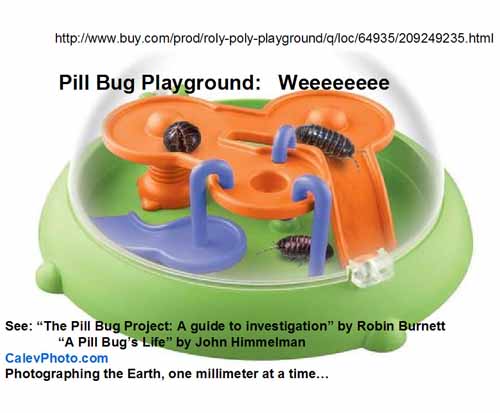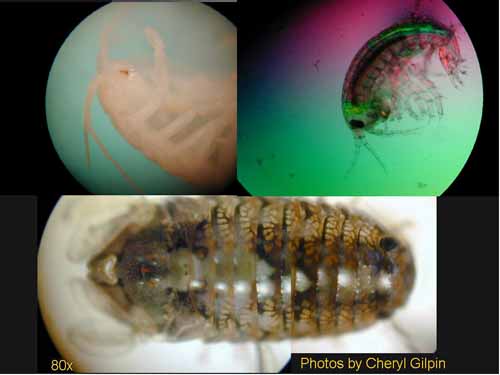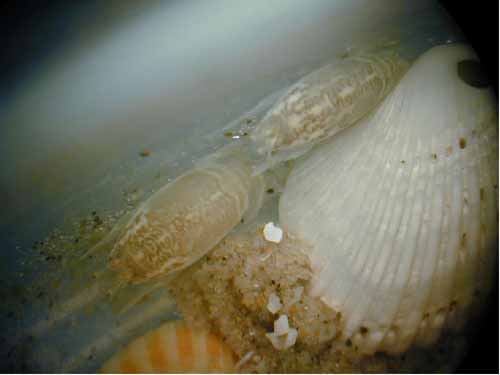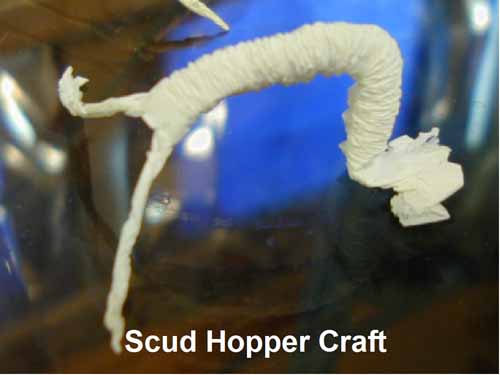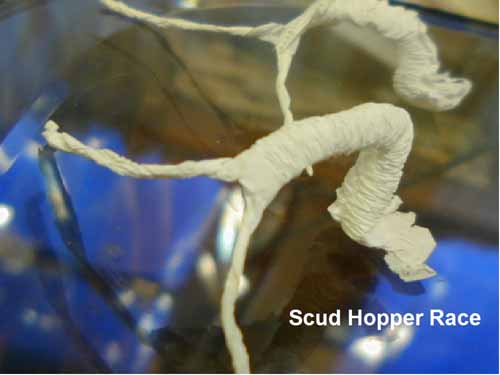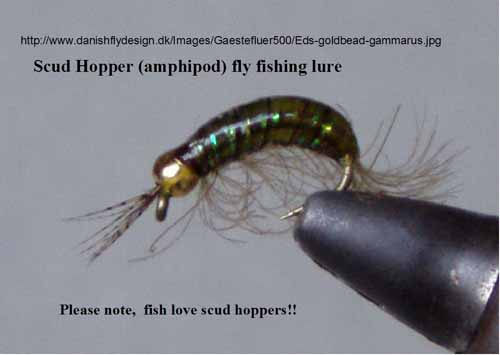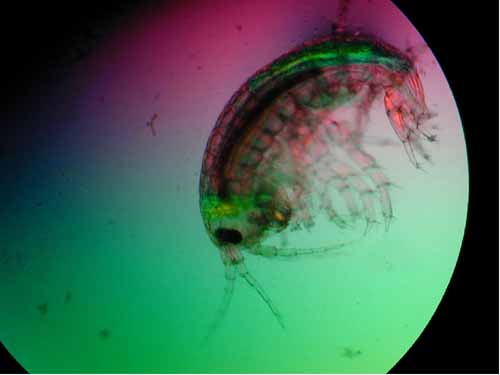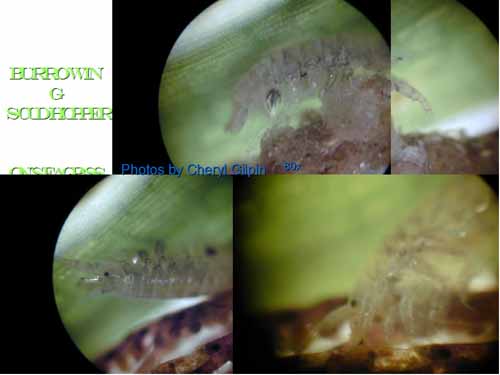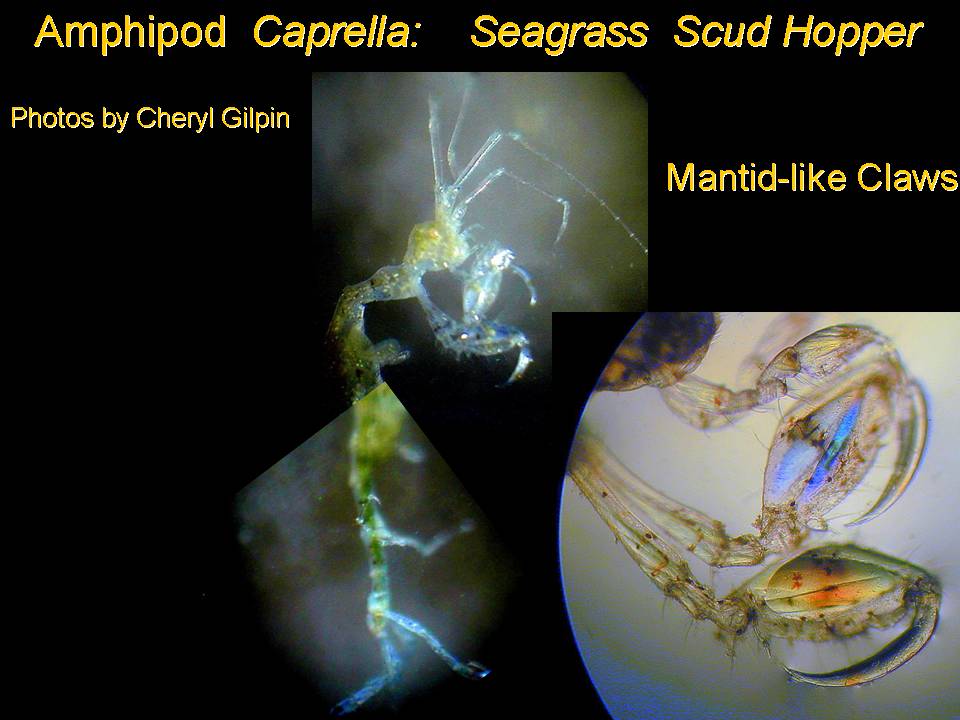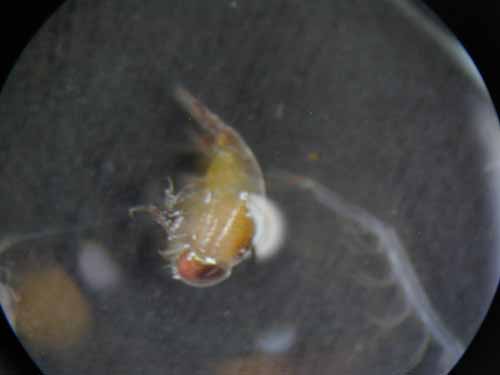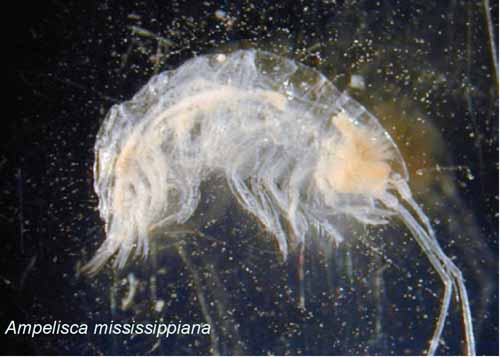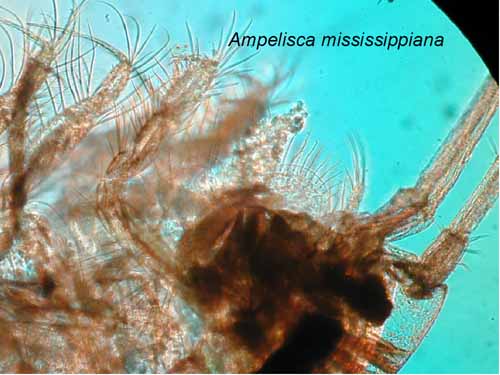|
Pick up some rocks in your garden and see if you can find some roly polys. Watch the roly poly (aka pill bugs) play inside a roly-poly miniature playground. Crawling, stretching, curling in a ball, rolling around, uncurling, waving. Place a moist piece of cotton inside.
Roly polys are not bugs, they are a type of crustacean called isopods. Iso = same, pod = feet. When the roly polys uncurl, count how many feet look the same. There is one type of roly poly people usually find in their garden. In the ponds and in the sea there are thousands of different kinds.
Look at these roly polys that live on seagrass in the Lower Laguna Madre (image 2 and 3) and in caves of the Edwards Aquifer (image 4), on the beach (image 5) and in the deep sea Mississippi Canyon under the Gulf of Mexico (image 6 and 6a).
When you are ready to take a hike to the pond, take them along in your roly poly bag so you can compare them with another tiny group of crustaceans, amphipods or scud hoppers. Later you can return the roly polys to moist soil where you found them and cover them back up.
Along the way stop and read about scud hoppers, a common name for Amphipods. Amphi = side. Scud hoppers or Amphipods have flat sides, they like to hang out around water plants and stringy algae. They almost disappear when you look at the plant because they are so thin (image 7).
Are roly polys flat on the sides, no they are flat on their
backs and fronts like you. The seagrass roly poly must rely on camouflage to help them
disappear and blend in (image 8). Look at the three crustaceans in image 8, can you tell which two are roly polys
and which is a scud hopper? Image 8a shows a larger image of the pond scud
hopper Gammarus, notice it is flat on the sides a characteristic of
amphipods.
When it's time for a drink and a snack, turn your paper straw covers into scud hoppers and have a hopping race (image 9 and 10).
Drop some water on one of the paper scud hoppers and see what happens. Unlike insects, scud hoppers actually have no wax on their exoskeleton to keep water from moving in and out of their skin so they easily dry up or may bloat up with water when there is a change in salt concentration. The amount of salt in the water changes its pressure on the skin and the flow of water thru the skin. So these shrimp-like crustaceans do not like changes in the saltiness of the water. They must have the right amount of freshwater flow wherever they are to survive. Fill a bucket with freshwater and one with salt water, place your hands inside baggies and dip them into the water at the same time one into freshwater and salt water without letting the water get higher than the baggie covering your hands. Can you feel the water as it squeezes pressure on your hand as it “shrinkwraps” the baggie to your hand? Does the salt water squeeze harder than the freshwater?
Garden scud hoppers are another shrimp-like crustacean that live on land. They are members of the group of Amphipods. They mostly live in the southern hemisphere of the globe. They like moist soil but they hop out onto sidewalks when it rains too much, then they may dry up and die if left out of the moist soil for too long.
When you get to the pond with a source of freshwater flow: Don’t forget …… scud hoppers make great fish food. Suggest your parents use a fishing lure that looks like a scud hopper. They might catch a fish (image 11).
Scoop up some of the pond water in a jar or bowl. Put your finger over one end of your straw, and put the other end in the jar. About 3-5 mm below the surface right near some tiny shrimp like crustacean zoo (animal) - plankton. Plankton is Greek for wanderer because plankton go with the flow.
Remove your finger from covering the top end of the straw let water and plankton move up into the straw. See the flow stops when the water level inside the straw balances with the water level outside the straw. Then cover the top of the straw with your finger again. Keep your finger on top of the straw like a lid and pull the straw out of the jar hold over a viewing container with a magnifying lens and remove your finger from covering the top of the straw again.
The flow stops when the water level inside the straw is the same as outside the straw again. But this time the water and plankton flow out.
Examine the scud hoppers inside the pond water with magnification. The amphipods make jerky hopping movements that help them hop around on stringy algae or plants. When swimming in the water it looks like they constantly start and stop, like they are taking little naps.
In some ponds, the plankton include varieties of scud hoppers. There are also varieties of scud hoppers in the coastal areas, on seagrass (image 12 and 13), open ocean (image 14 and 15) and far out in the Gulf of Mexico in the deep sea (image 16) and even the caves.
Roly polys and scud hoppers are the world’s most successful Crustaceans. They are the most widespread and diverse crustaceans.
They are diverse because unique species live in different habitats From the poles to the equator, From gardens to underground from mountain tops to deep sea canyons. However, their diversity is threatened. Some are endangered scud hopper species like the Peck’s Cave Amphipod that lives in Comal Springs, Texas (image 17). Endangered means they must be protected so the Earth will not lose them completely forever.
There has been enough water underground in limestone caves and springs for these life forms to survive for thousands of years even through many severe droughts or long periods with no rain. The springs would keep flowing, but not any more. Since we pump so much of the groundwater now, springs are likely to go dry when it does not rain for a long while. Before they go dry they might also get more salty. When you get thirsty, you need freshwater. When all you have is saltwater, you have to take the salt out to survive and that is not always possible because the salt that comes out of the water might make other water too salty and cause other life forms to die.
We must change our habits to ones that support keeping life diverse, that means with many different kinds of life because all of the Earth’s species are connected and depend upon each other. There is an endangered cave amphipod living in an aquifer under the US Capitol also. These species and many other unique cave wildlife are on the brink because people pump too much fresh water from the ground and much of the pumping is not even necessary.
While you soap up your hands or brush your teeth, don’t leave the water running until it's time to rinse. Turn the water off while busy cleaning and then turn it back on to rinse.
Think about how much water you save in a week and how much ten people doing this can save in a week. A year? You can help keep enough water in the caves for endangered scud hoppers that live underground. If most of your water in your homes and rivers comes from underground and you use it wisely that means the water will keep flowing out springs and out of your bathroom sink so you can rinse and stay clean.
So saving a diversity of scud hoppers and roly polys will help you have plenty of water too. This may also inspire your community to use water wisely.
Can you pretend to be a roly poly and curl up in a ball? Then can you pretend to be a scud hopper and take a quick nap.
Before you get up and start hopping again, please think about how important the flow of water is for life, especially yours and for the little tiny living things that flow with the water. So please use water wisely and inspire your community to do the same.
In the 1960s a song called “Let the sunshine in” was very popular. Replace the words “let the sunshine in” with the words “Let fresh water flow, let fresh water flow in” Sing it loud for the world to hear. Thank everyone who uses water wisely!!!!!!
Comments to the author Cheryl Gilpin are welcomed. Photos by Cheryl Gilpin © 2009 Other links: According to:
Visit the Micscape Library for other articles in the author's 'Microscopic Miracles' series.
|
